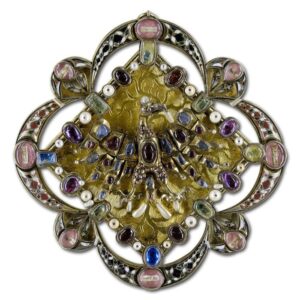
After Romanesque jewelry fell from fashion a new style emerged. Although parallels with the architectural style are minimal the style has been named Gothic. The architectural style already rose in the 12th century but the change in jewelry style lasted until the late 13th century. New techniques and an increased supply of precious stones, made possible by the strengthening of contacts with the East by the traders of Venice and Genova after the damage done by the crusades had faded away, together with the up-rise of larger cities in Europe caused a new fashion to emerge.
The transition from Romanesque to Gothic fashion occurred gradually. In the 1300’s luxury in the form of delicate and exotic clothing entered the French court. The wearing of jewelry was a way of expressing one’s rank in the social hierarchy. This, together with the increased availability of gemstones caused a series of laws to be called to life which restricted the use of jewelry. In Aragon, such laws occurred as early as 1234 followed by a French ordinance in 1283 and the English King Edward III in 1363. The laws forbade commoners to wear certain types of gem-set jewelry and in some cases, certain levels of wealth were mentioned which allowed one to wear golden objects adorned with precious stones. The increased supply of gemstones called for more regulation. A law from 1331 forbids the use of paste as a gemstone imitation in Paris and a law from 1355 prohibits the use of oriental pearls next to river pearls. Another one puts a punishment on placing tinted foils behind amethysts or rubies.
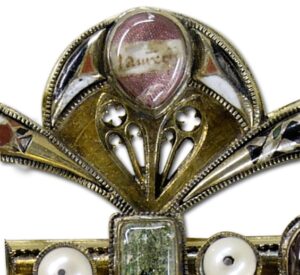
In London, the craft of goldsmith was officially recognized in 1327. Jewelry shops appear to have been selling small ready-made articles and do larger work on commission. The largest jewelry-producing centres of the High Middle Ages were Paris, which was famous for its jewelry throughout the Middle Ages, Venice, Bruges, Cologne, and Nuremberg. Jewelry styles were very much alike and it is often impossible to tell where a piece originated. Venice and Genova were by far the most important providers of precious materials, sourced by the cities’ traders from all over the East.
Materials, Styles, and Techniques
Gothic jewelry was more pointed than the rounded forms of Romanesque jewelry. In the 14th-century, we see little influence from the architectural style in jewelry but by the 15th century, its influence increases. Clarity of pattern and line was preferred over the heavy, dense detailing from the past. The result was a style that was more elegant. Stones were set against a plain surface or flat decoration such as niello or enamel. Gold remained the most prestigious metal.
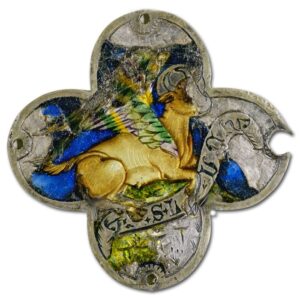
Around 1290 AD basse-taille enamel proved to be a logical sequence to the ancient technique of champlevé enamel. Some 70 years later the more complicated technique of email en ronde bosse was invented which allowed colorful enamels to be used in three-dimensional work. The earliest record of plique à jour comes from the 13th century as well.
From around 1375 the designs took on naturalistic characteristics and the outline of jewels were softened, something that was achieved by decorating the edge of an object with pearls on prongs. The most valued pearls were imported from the Persian Gulf in those days. The pearls were usually already drilled when they arrived in Europe, something that has led to the belief among the inhabitants of Europe that they occurred this way in nature.
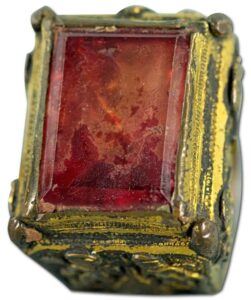
Over the Gothic period, gemstones started to play an increasingly important role in jewelry. Gem-cutting techniques developed by Indian and Persian lapidaries were introduced into Europe by the Venetians. Diamonds benefited most from this innovation until then only natural octahedrons in the case of diamonds and cabochons in the case of colored stones had been used in jewelry. In the 14th century, point-cut and table-cut diamonds claimed their role in jewelry designs. A shift in those designs can be observed, jewelry started to be made around the brilliance of the gemstone, and it became the center point of jewelry.
The art of gem-cutting and the greater availability of gems provided change but was a slow and gradual event, traditions proved to be deep-rooted. Bruges, situated in modern-day Belgium, became the cutting centre of Europe after the Burgundian court moved to the Netherlands in the mid-15th century. Emeralds, rubies, sapphires, and spinels were the most precious stones. As mentioned in the introduction laws against the use of imitation stones were put in place but legal imitations did exist. For children’s jewelry and funeral purposes, imitation stones were used legally.
Types of Jewelry
In the 13th century, the classic dress of Europeans consisted of a high-necked, long-sleeved underdress covered by a short-sleeved overtunic. These garments were worn by both sexes and left little room for jewelry except for belts and brooches which formed the larger part of jewelry of the early Gothic period.
The most common brooches were ring brooches, often inscribed with religious texts or expressions of love. One ring brooch of the 13th century, set with rubies and sapphires and decorated with pointillé motifs has the words ‘IO SUI ICI EN LIU DAMI : AMO’ engraved into the back of the brooch. Meaning: ‘I am here in place of the friend I love’. Another 13th-century ring brooch, a simpler one has just an inscription as decoration ‘IEO : SUI : FERMAIL : PUR : GAP : DER : SEIN – and – KE : NU : SVILEIN : NIMETTE : MEIN’ which can be translated: ‘I am a brooch to guard the breast that no rascal may put his hand thereon’. From these inscriptions, we derive that they were often presented as gifts between lovers.
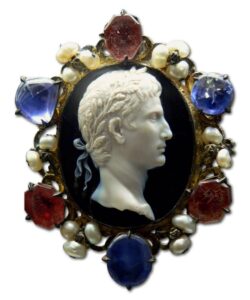
Cameos hadn’t lost their popularity since ancient times and antique ones were highly prized in the Gothic period as well. They were set in Gothic-style brooches: against clear backgrounds rather than heavily decorated ones. In the 14th century, brooches started to be more and more lavishly jeweled resulting in more complex jewellery but the designs remained elegant. In the late Gothic period (1375 – 1500) enamel, rather than gemstones, was used more intensively. Naturalistic details in the form of ladies, animals, and pairs of lovers became popular.
As said above the belt and the brooch were the two most common jewelry items. Belts could be of leather decorated with gold plaques, buckles and belt ends. In the Gothic period belt mounts often depicted an architectural motif, decorative initial letters or heraldic devices. At the end of the period saint depictions and religious quotations became popular as well.
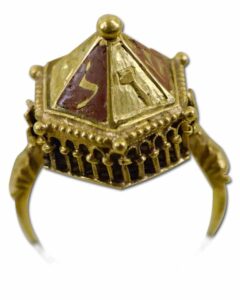
© Marie-Lan Nguyen.
Apart from belts and brooches, there were other jewelry items such as the ring. Rings were worn on all fingers and sometimes several per finger. They were decorated with (engraved) gems set in collets or held by claws or were just plain gold bands with or without engraving. Signet rings were used to seal and sign documents and rings were part of the wedding ceremony as well. The same ring was used for betrothals and weddings.

A second jewelry piece used in a wedding ceremony was the crown. Circlets and chaplets, as well as grander crowns called coronals, had come into fashion with the royalty at the beginning of the Romanesque period but in the Gothic period, they were worn by knights, squires and their ladies alike. Marrying with a crown on your head became so common that churches would have a few in stock so that those who couldn’t afford one could rent them. The Romanesque crowns had been decorated with golden rings and the Gothic addition to the design lay in the characteristic pinnacles called fleurons.
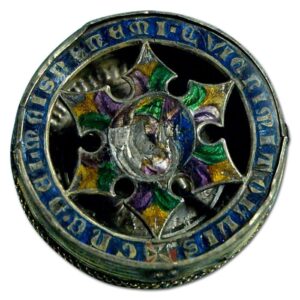
By the 1450s the high-necked dress made room for a new fashionable dress with a low neck. This triggered the return of the pendant. Other jewelry that was worn around the neck was the typical collars worn by nobles. Originally made of a fine fabric like silk or velvet and decorated with gold plaques the collar gradually was made out of gold only. Golden discs or plaques would be attached to form a chain. Collars were decorated with symbolic designs and often indicated membership to a knight’s order or specific function. In Europe, the mayor of a town still wears a collar on official occasions.
Devotional jewelry like badges of saints, paternosters, or Agnus Dei medallions were enjoying huge popularity. Badges were sold at pilgrim places and the Agnus Dei medallion was produced in Rome and blessed by the pope. The badges and medallions were worn as pendants, brooches and sewn onto clothing.
Sources
- Middeleeuwen, de Boer, D.E.H, van Herwaarden, J and Scheurkogel, J. Martinus Nijhoff uitgevers, Groningen, The Netherlands, 1995.
- 7000 Years of Jewellery, Various Authors, edited by Hugh Tait, British Museum Press, London, 1986.
- Jewelry, from Antiquity to the Present, Phillips, Clare, Thames & Hudson, London, 1996.
- A History of Jewellery 1100-1870, Evans, Joan, Dover Publications, Inc, New York, USA, 1953/1970.